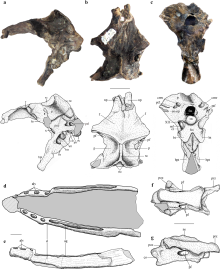Allkaruen
| Allkaruen | |
|---|---|

| |
| Skeletal elements | |
| Scientific classification | |
| Domain: | Eukaryota |
| Kingdom: | Animalia |
| Phylum: | Chordata |
| Order: | †Pterosauria |
| Clade: | † Macronychoptera
|
| Clade: | †Novialoidea |
| Clade: | † Breviquartossa
|
| Clade: | † Pterodactylomorpha
|
| Genus: | †Allkaruen Codorniú et al. 2016[2] |
| Species: | †A. koi
|
| Binomial name | |
| †Allkaruen koi Codorniú et al. 2016[2]
| |
Allkaruen (meaning "ancient brain") is a
It contains a single species, Allkaruen koi.Description

As demonstrated by a
The parietals of Allkaruen were long, being 60% of the length of the frontals; the frontals themselves were broad, flat, and extensively pneumatized. The lower jaw was about 3.5 times the length of the section of the skull that is preserved, and it is curved upwards at its tip. The dentary bore four or five tooth sockets in its front half, and in the latter half they were replaced by a groove; this combination is unique among pterosaurs.[2]
Allkaruen was a small pterosaur. The holotype specimen would have been an adult, since its skull was entirely fused.[2]
Discovery and naming
The holotype of Allkauren consists of a braincase (MPEF-PV 3613), a mandible (MPEF-PV 3609), and a cervical vertebra (MPEF-PV 3615); a similar cervical vertebra (MPEF-PV 3616) was also referred to the genus.[2] These elements were in 2000 discovered in the Cañadón Asfalto Formation, Cerro Cóndor, Chubut, Argentina, which has been dated to the Middle-Late Toarcian, 179.17 ± 0.12-178.07 ± 0.21 m.a (although earlier estimates have suggested an earliest-Bathonian age).[4][5] Other elements, mostly disarticulated and consisting of a number of limb bones as well as another mandible, were also discovered at the site.[2][6]
The name Allkaruen is Tehuelche in origin, being derived from all ("brain") and karuen ("ancient"). The specific name, koi, originates from the Tehuelche word for "lake", in reference to the fact that the type locality would have been a saline lake.[2][7]
Classification
In 2016, two
In their 2024 description of
| Monofenestrata |
| |||||||||||||||||||||
References
- S2CID 225120452. Retrieved 27 August 2021.
- ^ PMID 27635315.
- ^ S2CID 4431861.
- . Retrieved 2 May 2022.
- hdl:11336/78351.
- ^ Codorniú, L.; Rauhut, O.W.M.; Pol, D. (2010). "Osteological features of Middle Jurassic pterosaurs from Patagonia (Argentina)". Acta Geoscientica Sinica. 31 (suppl. 1): 12–13.
- S2CID 129090656.
- PMID 19828548.
- ISSN 0272-4634.
